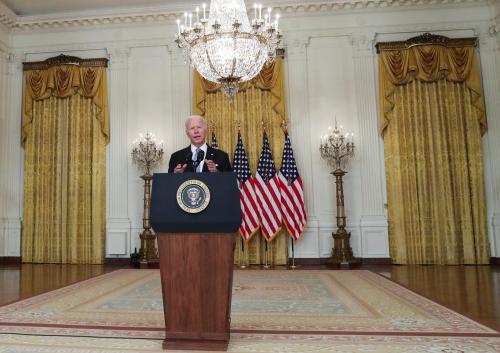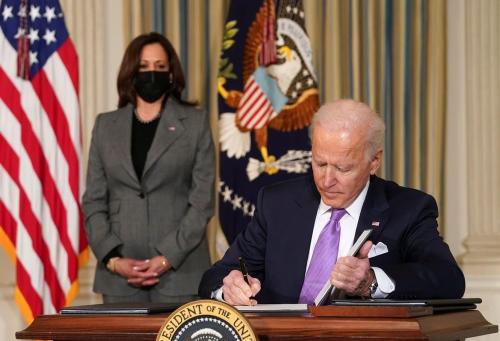A funny thing happened on the way to President Biden signing a historic, bipartisan, popular infrastructure bill—he lost popularity. His approval ratings sank.
So what happened?
The country’s chaotic departure from Afghanistan at the end of August definitely had an effect, as did the return of inflation. But during this time, Americans were also being bombarded with minute-by-minute commentary on the progress of the infrastructure bill and the Build Back Better bill containing Biden’s social and family agenda. People in the know and people out of the know pontificated on the negotiations. While no one disputes the fact that the contents of both bills are very popular, it seems that the very process of passing the infrastructure legislation turned people off not only to the Congress (Congress as a whole is never very popular), but to the president himself.
The 19th-century Prussian politician, Otto Von Bismarck once said, “Laws are like sausages. It is best not to see them being made.” It has been repeated millions of times since then as a good description of the legislative process. But this year, legislative sausage-making fully emerged from back rooms into the Twitterverse. Speaker Nancy Pelosi put it best when she told reporters: “‘This is the Democratic Party.’ In the old days, she suggested, a deal between warring factions—like the ones led by Congressional Progressive Caucus Chair Pramila Jayapal (D-Wash.) and moderate leader Josh Gottheimer (D-N.J.)—all got worked out behind the scenes. [In 2021], she lamented, it played out ‘on 24/7 platforms where there are opinions going out, characterizations going out before anybody even knew what was going on.’”
The legislative process turned out to be more unpopular than the legislation.
This was not always the case. Take the 1986 tax bill passed by a Democratic Congress and signed into law by a Republican president, Ronald Reagan. It was and still is considered a model piece of tax legislation since it closed many corporate loopholes and lowered tax rates for many Americans. But passing it was no walk in the park. The legislation was introduced by Democrats in the summer of 1982, a Republican version was introduced in the spring of 1984, and the Reagan White House released its own version that fall following the president’s landslide victory in the 1984 elections. It wasn’t signed into law until October 1986. Along the way it had many near-death experiences according to journalists Jeffrey Birnbaum and Alan Murray, whose classic book, “Showdown at Gucci Gulch: Lawmakers, Lobbyists and the Unlikely Triumph of Tax Reform,” pulled back the curtain on the legislative sausage making that went into the passage of the bill. It nearly died from lobbyists adding new tax breaks for business, it nearly died when House Republicans defeated the “rule” (a way of voting against the bill without really voting against it), and it nearly died again from the sheer weight of special interest amendments.
The media environment of the 1980s stands in sharp contrast to today’s around the clock news coverage. In this different era of reporting, the American people were left largely in the dark about the day-to-day political drama that characterized more than four years of tax negotiations. In 1986, most Americans got their news from the daily newspaper or from an anchor on one of the “Big Three” broadcast networks: ABC, CBS, and NBC. Pew Research Center estimates that the total circulation of U.S. daily newspapers exceeded 62 million in 1986 (compared to 24 million in 2020). The country’s first cable news channel, CNN, was founded in 1980, but it was still gaining its footing as negotiations around the Tax Reform Act began. Legislators in 1986 had to dodge lobbyists in Gucci loafers as they emerged from their negotiations, but they didn’t have to dodge ubiquitous cameras and cell phones. Nor were they subject to Twitter discourse.
A contentious legislative environment was not unique to the 1980s. Fast forward nearly 20 years when President George W. Bush and a significant number of congressional Republicans wanted to pass legislation to expand prescription drug coverage via Medicare. As President Bush campaigned for re-election in 2004, many believed such a policy expansion would be a way to strengthen the president’s chances of securing the vote among older, middle-class Americans.
Enhanced conversations around expanding coverage began after Republicans added to their congressional majorities in the 2002 midterms, and outlines of plans and more detailed negotiations began in the early months of 2003. However, President Bush and the plan’s supporters in Congress faced a difficult test in cobbling together necessary majorities. Democrats felt the plans being discussed did not protect seniors sufficiently, and conservative Republicans believed it was an unnecessary expansion of big government. Ultimately, House Speaker Dennis Hastert introduced H.R. 1, the Medicare Prescription Drug, Improvement, and Modernization Act of 2003 on June 25.
The expedited nature of its passage—the bill would be signed into law just over five months later—masked the reality of the process: The legislation was on life support at many times during negotiations. That process included the longest House vote in recorded history on June 27, when Republican leadership held the vote open for more than three hours while arm twisting reluctant members. Before the bill’s passage, the secretary of Health and Human Services would make the unusual and widely criticized decision to go to the House floor to pressure members. Later, congressional Republicans would make loud allegations of political kickbacks. Ultimately, one member from Oklahoma, who eventually voted nay, switched his vote to present so the House could pass the initial version, 216-215-1.
Negotiations in the Senate were also tense and faced serious challenges from both Democrats and Republicans over the course of months. For final House passage, Republicans needed 16 Democrats to pass the bill, as 25 Republicans voted nay. On final passage in the Senate, Republicans needed a sufficient number of Democrats to hold their nose and vote for cloture, and then still required 11 Democrats and an Independent to help overcome the nine Republican senators who opposed. Ultimately, this was a bruising, costly battle for congressional Republicans, President Bush, and the legislation itself, as polling showed a majority of Americans opposed the bill.
By the time Medicare prescription drug coverage was debated, cable news had become a dominant force in the American media environment. About 19% of American adults said CNN was their primary source of news and an additional 18% said they got most of their news from Fox. Americans were also beginning to turn to the internet as a source of news. In March 2003, Pew reported that 44% of online Americans had used the internet to search for reports about the Iraq War. The internet revolutionized the American media environment by providing a way for people to get free access to breaking political news and commentary. The same sources that allowed Americans to follow international affairs with increased intensity also provided coverage of the effort to pass Medicare Part D. Still, the scrutiny health-care reform received in 2003 has nothing on the contemporary media environment.
Today, cable news provides nonstop coverage of just about everything, and this is amplified by Facebook, used by 69% of U.S. adults, and Twitter, used by 23% of adults. “[U.S. Rep.] Jayapal told me Biden called her mom in India after the vote tonight,” tweeted one CNN correspondent. But posts about ongoing legislative efforts weren’t limited to politicians and the journalists that cover them. In today’s media universe, everyone is an insider, everyone has an opinion, and everyone was quick to jump on the bandwagon as they breathlessly tracked each twist and turn in the infrastructure negotiations on social media.
The challenges of finding majorities in a collective body like the U.S. Congress around controversial policy issues have always existed, regardless of whether the news cycle is continuous or more piecemeal. In the same way that President Biden’s infrastructure bill limped across the finish line, other presidents of both parties have faced the same issues with signature pieces of legislation. But for President Biden, an already difficult job was made even harder because of social media’s omnipresence in informing and misinforming Americans about legislation, legislators, and the legislative process. Compared to past negotiations over major pieces of legislation, the fight over the infrastructure bill was not very long and not unusually contentious. But we didn’t used to see that play out in real time before the public. And the public, not accustomed to the sausage-making of legislation, got to the point where the process became more important than the policy—and President Biden suffered.
The Brookings Institution is committed to quality, independence, and impact.
We are supported by a diverse array of funders. In line with our values and policies, each Brookings publication represents the sole views of its author(s).









Commentary
Did legislative sausage-making hurt President Biden?
December 13, 2021